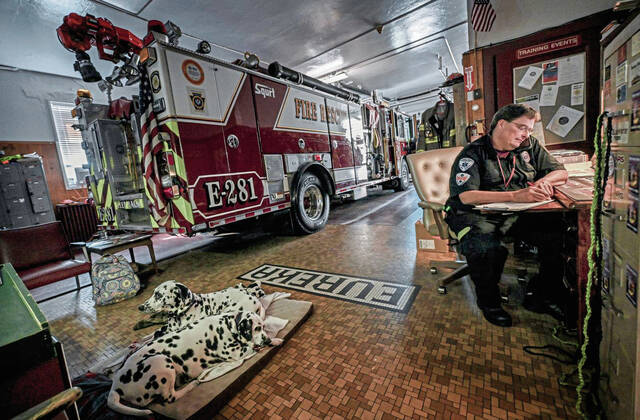Dwindling donations, personnel leave Tarentum fire chiefs welcoming state talks about future
It wasn’t too many years ago that firefighters bristled at the mention of consolidation.
“There’s a difference now,” said Brad James, assistant chief at Eureka Fire and Rescue in Tarentum. He’s been in the emergency service business for 40 years.
“It doesn’t matter much anymore whether you’re for it or against. It’s going to be the only way to survive.”
Tarentum Council will launch a state-led study of its three fire departments — Eureka, Summit Hose and Highland Hose — to learn how to plan for the future.
“Nobody wants to see their fire departments dissolving,” Borough Manager Dwight Boddorf said. “This is just a conversation to see what we need to do to have a good fire service. How do we budget for new equipment that costs more than $1 million?
“At some point, the engines will fail, and we don’t have a plan for replacing them.”
A peer-to-peer study by the state Department of Community and Economic Development will look at finances, garage upkeep, equipment cost, training and other expenses.
The cost of doing business has risen, James said, and fire departments typically get little support through fund drives.
“There is way too much emphasis on fundraising rather than training,” he said. “You want someone to show up at your scene who is well-trained, not someone who is well-versed in hoagie sales.”
Summit Hose Chief Josh Fox said a state fire expert will talk with the chiefs and the borough manager about a path toward a healthy future for fire services.
Highland Hose Chief Mike Koval said the study is “most definitely” needed.
He said a similar study was done about 2004. Another one was prepared to launch in 2020, just before covid, but was canceled.
“They probably just want to have one department,” he said. “We’ll have to make it work. If they don’t do something, they’re going to end up with a municipal-paid department, and I don’t think they want that.”
It’s no secret that the landscape of emergency services has changed drastically.
There were more than 300,000 providers across the state in the 1970s, James said. Today, the number hovers around 50,000.
At Eureka, there was an active roster of about 45 members in the early 1980s. That’s cut in half now.
“Not only are there fewer providers, but the average age has crept up from people in their 20s and 30s to people above 50,” James said.
Council President Scott Dadowski applauded the study, saying: “It all needs to be talked about. The nice thing is that the fire chiefs are all involved.”
The study will follow a similar format of last year’s police review of Tarentum and Brackenridge, which ended in Tarentum absorbing the three Brackenridge officers.
“We’re not saying that’s what’s going to happen, but the experts will come in and help figure out what’s appropriate,” Boddorf said.
The Highland Hose fire hall on East Eighth Avenue is large enough to accommodate volunteers from the other departments, Koval said.
But, he added, “no one wants to lose their home.
“We’d make it work. We’ll have to figure something out.”
James welcomes the study because, he said, it should help a larger pool of people understand the constant struggle of fire personnel.
“The public expects a service from us, and we can’t always provide it, given the changes,” James said. “This is a good way for everyone to be educated.”
Tawnya Panizzi is a TribLive reporter. She joined the Trib in 1997. She can be reached at tpanizzi@triblive.com.
Remove the ads from your TribLIVE reading experience but still support the journalists who create the content with TribLIVE Ad-Free.




